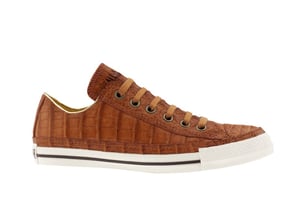 Here’s a question we get a lot on calls with designers getting ready to make an exotic leather product: “Do I really need a grade I skin for my project, or can I use a different skin?”
Here’s a question we get a lot on calls with designers getting ready to make an exotic leather product: “Do I really need a grade I skin for my project, or can I use a different skin?”
It’s very understandable: Grade I skins that are free of flaws are almost always in high demand, so they’re often more expensive and difficult to find than Grade II, III, or IV skins that have flaws.
The answer to this question depends largely on what your project is and the type of skin you plan on working with.
When Would You Need a Grade I Skin?
Grade I skins are really only required for handbags. Handbags frame the prime center cut of the skin and there aren’t many chances to work around or hide a scratch or hole in the hide. So, to keep your final product looking its best, a grade I skin is the clear choice.
Also, some exotic leathers come from farmed sources, which makes getting higher-grade skins a bit easier. For example, some species of python are farmed for their skins, so larger grade I and II hides are frequently available. On the other hand, alligator skin is also mostly farmed, but in such high demand that it is hard to find. And even when you do find it, it's typically very expensive.
Why Would You Want a Grade II, III, or IV Skin?
Flawless grade I skins offer the best quality you can get for any kind of hide. So, why would you ever want to use lower-grade skins that have flaws?
The biggest reason has to do with cost. Grade II, III, and IV skins are more affordable than their grade I counterparts. This can allow you to order more total useable hide than what you could get if you only ordered grade I hide.
For example, say you had a $10,000 budget for skins. In this hypothetical example, a grade I skin measuring 5 sq. ft. costs $100, while a grade II skin measuring 6 sq. ft. cost the same amount. Ordering just grade I skins would give you 500 sq. ft. of material to work with, while ordering the grade II skin would net you 600 sq. ft. of material in total.
If working around the flaws would take away an average of half a square foot from each grade II hide, you’d still have 550 sq. ft. of hide—an extra 50 sq. ft. of material to work with for the same cost!
Grade II and III hides are often used for making items such as garments, footwear and other small leather goods. Grade III and IV hides are often used for belts and small leather goods where the panel sizes are smaller and it’s easier to work around flaws in the hide.
It may take some extra work to go around flaws in the hide, but ordering grade II, III, and IV hides can help you get more bang for your buck when it comes to your exotic skin order.
Which grade of exotic leather is right for your next project? Find out by consulting with Pan American Leathers today!



